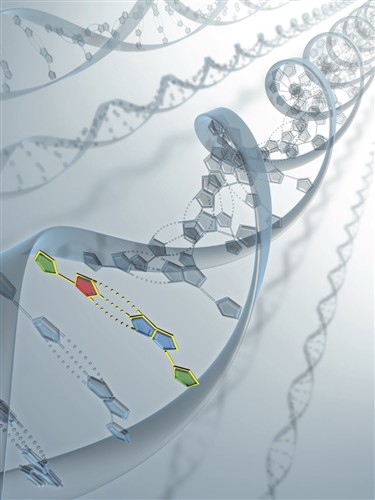DNA, RNA and Chromosomes
 DNA, or deoxyribonucleic acid, is a remarkable substance. Its molecular structure was first established in the 1950s by Jim Watson and Francis Crick at Cambridge, who also drew on the earlier work of Maurice Wilkins and Rosalind Franklin in London. Its double helical structure consists of two intertwined sugar-phosphate strands, bonded together by the base pairs adenine (A) which pairs with thymine (T), and cytosine(C) with guanine (G). There are 3 billion bases in a single molecule of DNA and the genetic information is encoded in the sequences of the bases. RNA (ribonucleic acid) is similar to DNA, but its molecules are shorter and uracil (U) replaces thymine (T). Each triplet of bases codes for an amino acid which is an essential ingredient in the process of protein synthesis.
DNA, or deoxyribonucleic acid, is a remarkable substance. Its molecular structure was first established in the 1950s by Jim Watson and Francis Crick at Cambridge, who also drew on the earlier work of Maurice Wilkins and Rosalind Franklin in London. Its double helical structure consists of two intertwined sugar-phosphate strands, bonded together by the base pairs adenine (A) which pairs with thymine (T), and cytosine(C) with guanine (G). There are 3 billion bases in a single molecule of DNA and the genetic information is encoded in the sequences of the bases. RNA (ribonucleic acid) is similar to DNA, but its molecules are shorter and uracil (U) replaces thymine (T). Each triplet of bases codes for an amino acid which is an essential ingredient in the process of protein synthesis.
The information in DNA is held in short sequences or genes, of which there are about 24,500 in the human genome. The DNA is packaged in a highly ordered manner in the chromosomes of which there are 46 in human cells. Messenger RNA copies segments of the information in DNA and carries it out of the nucleus where it is eventually used to assemble specific proteins in the ribosomes deep within the cell.
The chemical constituents in DNA function like letters in a written language or symbols in a computer code. Just as English letters may convey a particular message depending on their arrangement, so too do certain sequences of chemical bases along the spine of a DNA molecule convey precise instructions for building proteins. The arrangement of the chemical characters determines the function of the sequence as a whole. Thus, the DNA molecule has the property of ‘sequence specificity’ that characterizes codes and language. As Richard Dawkins has acknowledged, ‘the machine code of the genes is uncannily computer-like.’ As Bill Gates has noted, ‘DNA is like a computer program, but far, far more advanced than any software we've ever created.’
After the early 1960s, further discoveries made clear that the digital information in DNA and RNA is only part of a complex information processing system - an advanced form of nanotechnology that both mirrors and exceeds our own in its complexity, design logic and information storage density.
Norman Nevin
Late Emeritus Professor of Medical Genetics
Queens University
Belfast
Northern Ireland
(Prof Nevin was President of the Centre for Intelligent Design until his death in 2014)
Image credits:
Thumbnail - © Thomas Shafee - This file is licensed under the Creative Commons Attribution 4.0 International licence.
Article image - licence to use held by C4ID